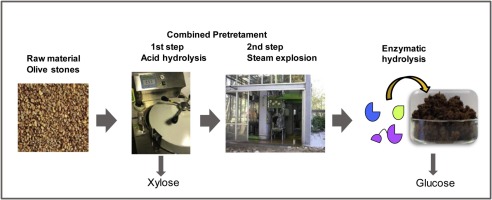Industrial Crops and Products ( IF 5.6 ) Pub Date : 2020-03-02 , DOI: 10.1016/j.indcrop.2020.112279 C. Padilla-Rascón , E. Ruiz , I. Romero , E. Castro , J.M. Oliva , I. Ballesteros , P. Manzanares

|
Olive stones are a lignocellulosic biomass generated as a by-product in the olive oil industry. They are of interest for use as a feedstock in the production of biofuels and other bioproducts in a biorefinery context. The aim of this work was to evaluate the potential of sugar production from olive stones, as a first approach in a valorisation process for this by-product. The process strategy tested consisted of a sequential fractionation process of the lignocellulosic components of olive stones based on acid pretreatment and steam explosion followed by enzymatic hydrolysis. In the first acid step, the study of pretreatment temperature, sulfuric acid concentration and biomass loading led to optimized conditions of 128 °C, 10.5 g acid/100 g olive stones and 33 % solids. This yielded a pre-treatment liquor with a xylose recovery of 71 %. In the steam explosion pre-treatment, the influence of increasing temperature from 180 to 225 °C at a fixed time of 5 min was evaluated through the assessment of sugar recovery and the enzymatic digestibility of sequentially pretreated olive stones. This permitted the selection of the most adequate steam explosion conditions (i.e., 195 °C for 5 min). As a result of the combined pretreatment under the selected operation conditions, an overall sugar production yield of 83 % of the total sugar content in raw olive stones can be obtained, taking into account the different sugar streams generated along the whole process.
中文翻译:

使用顺序的酸/蒸汽爆炸预处理对橄榄石副产品进行增糖以制糖
橄榄石是木质纤维素生物质,是橄榄油行业中的副产品。在生物精炼厂中,将它们用作生产生物燃料和其他生物产品的原料非常有趣。这项工作的目的是评估橄榄石制糖的潜力,这是该副产品在增值过程中的第一种方法。测试的过程策略包括基于酸预处理和蒸汽爆炸,然后进行酶促水解的橄榄石木质纤维素成分的顺序分馏过程。在酸的第一步中,对预处理温度,硫酸浓度和生物质负荷的研究导致了128°C,10.5克酸/ 100克橄榄石和33%固体含量的优化条件。这产生了木糖回收率为71%的预处理液。在蒸汽爆炸预处理中,通过评估糖的回收率和顺序预处理的橄榄石的酶消化率,评估了在5分钟的固定时间将温度从180升高至225°C的影响。这样就可以选择最合适的蒸汽爆炸条件(即195°C持续5分钟)。在选定的操作条件下进行联合预处理的结果是,考虑到整个过程中产生的不同糖分流,可获得的总产糖量为生橄榄石中总糖分的83%。通过评估糖的回收率和顺序预处理的橄榄石的酶消化率,评估了在5分钟的固定时间内将温度从180升高至225°C的影响。这样就可以选择最合适的蒸汽爆炸条件(即195°C持续5分钟)。在选定的操作条件下进行联合预处理的结果是,考虑到整个过程中产生的不同糖分流,可获得的总产糖量为生橄榄石中总糖分的83%。通过评估糖的回收率和顺序预处理的橄榄石的酶消化率,评估了在5分钟的固定时间内将温度从180升高至225°C的影响。这样就可以选择最合适的蒸汽爆炸条件(即195°C持续5分钟)。通过在选定的操作条件下进行联合预处理的结果,考虑到整个过程中产生的不同糖分流,可以获得的总糖分产率为生橄榄石中总糖分含量的83%。











































 京公网安备 11010802027423号
京公网安备 11010802027423号